Modern Marketing Strategy Frameworks
Goal Setting & Measurement
Brand & Briefing
Research & Insight
Communications Planning
Prioritization & Planning
Brand Strategy Framework
Description
The purpose of the Brand Strategy Framework is to clearly and concisely articulate what your brand stands for. A strong brand strategy is critical for making focused, consistent, and effective marketing decisions for your product, service, or organization. There are several different frameworks used by marketers to capture brand strategy. Most have some version of the elements listed in this framework: Essence, Values, Character, Benefits, and Attributes. I am a fan of this pyramid-style framework because it reinforces the overarching importance of a brief articulation of Brand Essence (you can’t fit too many words in the top of a pyramid). It also helps you to ensure that all elements are aligned – from top to bottom.
Questions
The Brand Strategy Framework helps to answer marketing questions like:
What does my brand ultimately stand for?
How does my brand differ from my competitors?
What does my brand provide that benefits people?

Steps
Start at the top, and work down. Your Essence is the DNA of your brand. Ask questions like ‘Why does our brand exist?’ and ‘What do we promise?’ Be single-minded and brief with your answer– 5 words or less.
Your Values are your compass. They represent the principles that will guide your decisions and actions. Ask questions like ‘What do we believe in?’ and ‘What do we stand for’? Capture up to 5.
Your Character is your personality; traits that personify your brand and create mental associations with consumers. Ask yourself, ‘How would my target consumer describe my brand if it were a person?’ Capture up to 5.
Your Benefits are what you provide to your consumers, functionally and emotionally. Ask questions like ‘What positive feelings do consumers receive?’ and ‘What utility do we provide?’ Capture up to 7 in total.
Your Attributes are how you provide your Benefits. They are the features of your offering – the more valuable, distinctive, and provable the better. Ask yourself, ‘What makes our offering better than our competitors?’
Considerations
Do not confuse your Brand Essence with your tagline; your tagline is an expression of your brand.
Ensure your brand strategy is aligned and defensible – do your Attributes support your Benefits?
Be as specific and concise as possible, so your framework can be used to guide challenging marketing decisions
References
Ries, A., Trout, J. “Positioning: The Battle for Your Mind”, McGraw-Hill, 2001
Search Moment Framework
Description
The purpose of the Search Moment Framework is to identify opportunities to engage and serve customers in moments of need through search marketing. This Framework is based on the Micro-Moments concept developed by Google. This concept identified four emerging moments of need that customers were turning to search – and more specifically mobile search – to address. The opportunity for marketers is to explore how these moments relate to their own customers and businesses as the basis for new search marketing campaigns. These search marketing campaigns can include both executing paid search advertising and creating search engine optimization (SEO)-friendly content to target relevant search queries. The goal is to increase the share of search intent that your brand captures within search engine results pages (SERPs).
Questions
The Search Moment Framework helps to answer marketing questions like:
What new types of search queries should we consider targeting with search marketing?
What areas of search intent should we be focusing on most?
How has mobile impacted what our customers might be searching for?
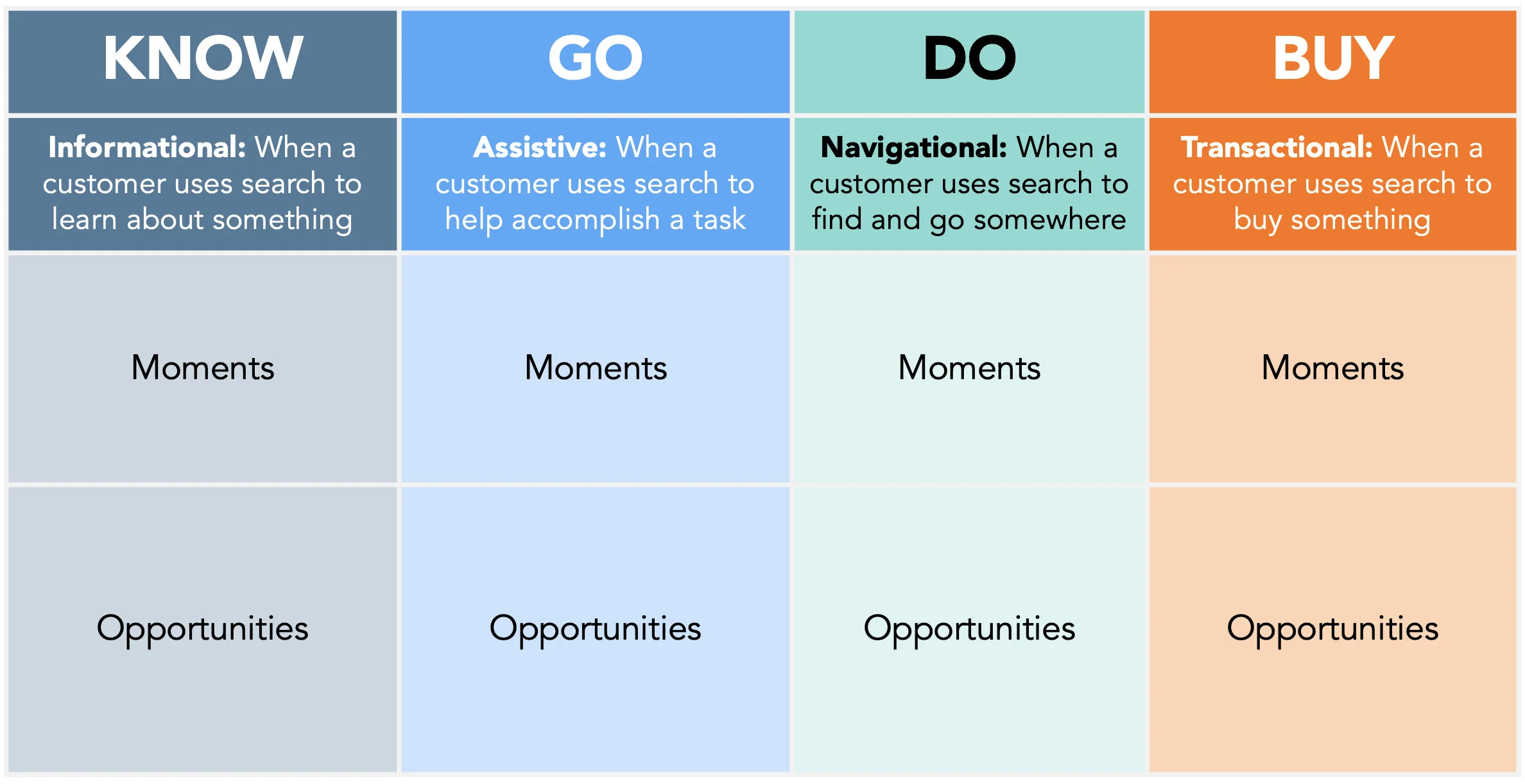
Steps
To start, make sure that you are clear on the nature of the target customer and the journey they are on, or the goal that your customer is trying to ultimately achieve. This will form the basis for your exploration.
Explore Know moments by considering any informational barriers that may prevent a customer from choosing you. What are they unclear about? What topics might they want to research or dig deeper on?
Explore Go moments by considering location-based way-finding questions that your customer may have on their journey. Do you have a location near me? What are your hours of operation?
Explore Do moments by considering relevant and common tasks that your customer may be trying to complete. What might they need help with? What ‘how-to’ content might our customer find valuable?
Explore Buy moments by considering the steps that a customer might take along their path to purchase-online and offline. Where can I buy this online or near me? Who is selling this at the best price?
Considerations
Once completed, research the relative volume of each search query to determine the size of audience
Research the relative level of competition for each search query to determine the cost for paid search
Conduct this exercise as part of major changes in the marketplace that may impact search behaviour
References
Measurement & Reporting Pyramid
Description
The purpose of the Measurement & Reporting Pyramid is to determine the nature of the reporting that is required for different stakeholders relating to an initiative. Often, marketing reporting teams end up sharing the same ‘one size fits all’ reports with everyone that are not relevant or actionable. These reports are often ignored, as they do not provide a basis for decision-making. The Measurement & Reporting Pyramid helps you determine what different teams or levels need to know early in the process so the proper tracking, dashboards, and communication pieces can be put in place. Completing the Pyramid also allows reporting teams to focus their valuable time and energy on the metrics that matter most.
Questions
The Measurement & Reporting Pyramid helps to answer marketing questions like:
What metrics do we need to track and report on for this initiative?
What are the reporting needs of different teams and stakeholders?
In what format and frequency do reports need to be shared?
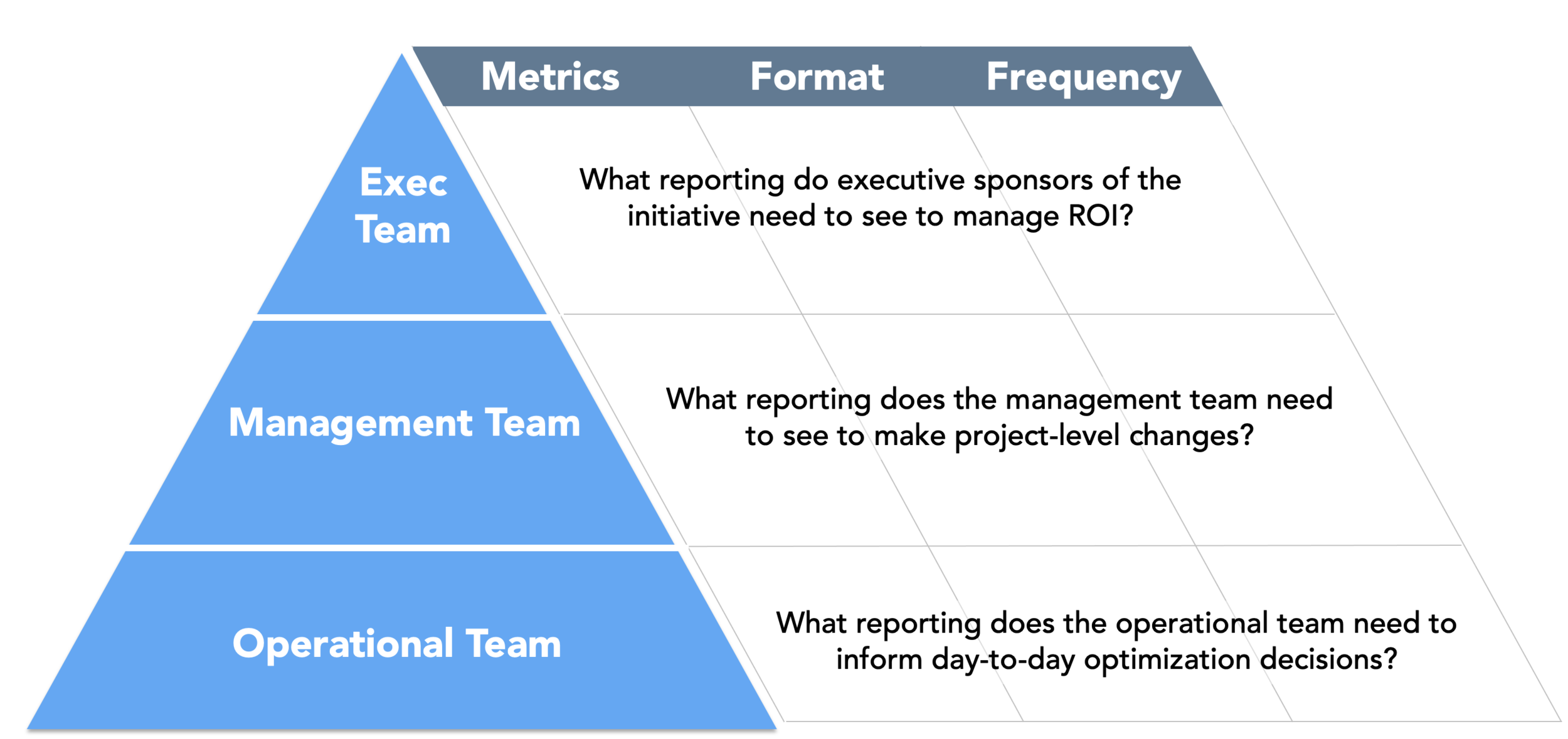
Steps
Review the goals, scope, and KPIs for the initiative that you are planning. If completing the framework as a team, ensure that everyone has a shared understanding of the initiative.
Identify the different people that need to be informed of the performance of the initiative. Large or complex initiatives will have many stakeholders, small and simple initiatives will have fewer.
For each stakeholder or team, identify the smallest number of metrics that they need to know to make decisions regarding the initiative. Include the stakeholders in the process for input and alignment.
For each stakeholder or team, determine the ideal format and frequency of reporting. For example, the business sponsor may need to present the resulting sales numbers for a weekly management meeting.
Once drafted, review the completed Pyramid with the marketing reporting team. Validate that the people, processes, and tools are available to deliver on the reporting plan. Revisit if plan is not feasible.
Considerations
Remember why the framework is triangular, and share a roll-up of business metrics with senior teams
Do not use this framework for identifying KPIs, use it for identifying how KPIs will be captured and shared
Ensure you are reporting on metrics that guide decisions. Avoid interesting, but unactionable reports
References
Prioritization Mapping Framework
Description
The purpose of the Prioritization Mapping Framework is to organize and visualize the relative priority of different marketing initiatives for your organization. To use the Prioritization Mapping Framework, you need to have a clear idea of how value and complexity will be determined; the Prioritization Criteria Framework can be used here. This framework is commonly used in workshop settings, as teams evaluate different initiatives and plot them on the corresponding quadrant. The process of completing the framework together helps teams to appreciate that all initiatives cannot be scored High Value, and that choices need to be made. The output of this framework then becomes the input for a project plan or phased roadmap.
Questions
The Prioritization Criteria Framework helps to answer marketing questions like:
What initiatives make sense to execute first, and what can come later?
What initiatives are ‘low hanging fruit’ that we should execute now?
What initiatives should we park and not spend further resources on?
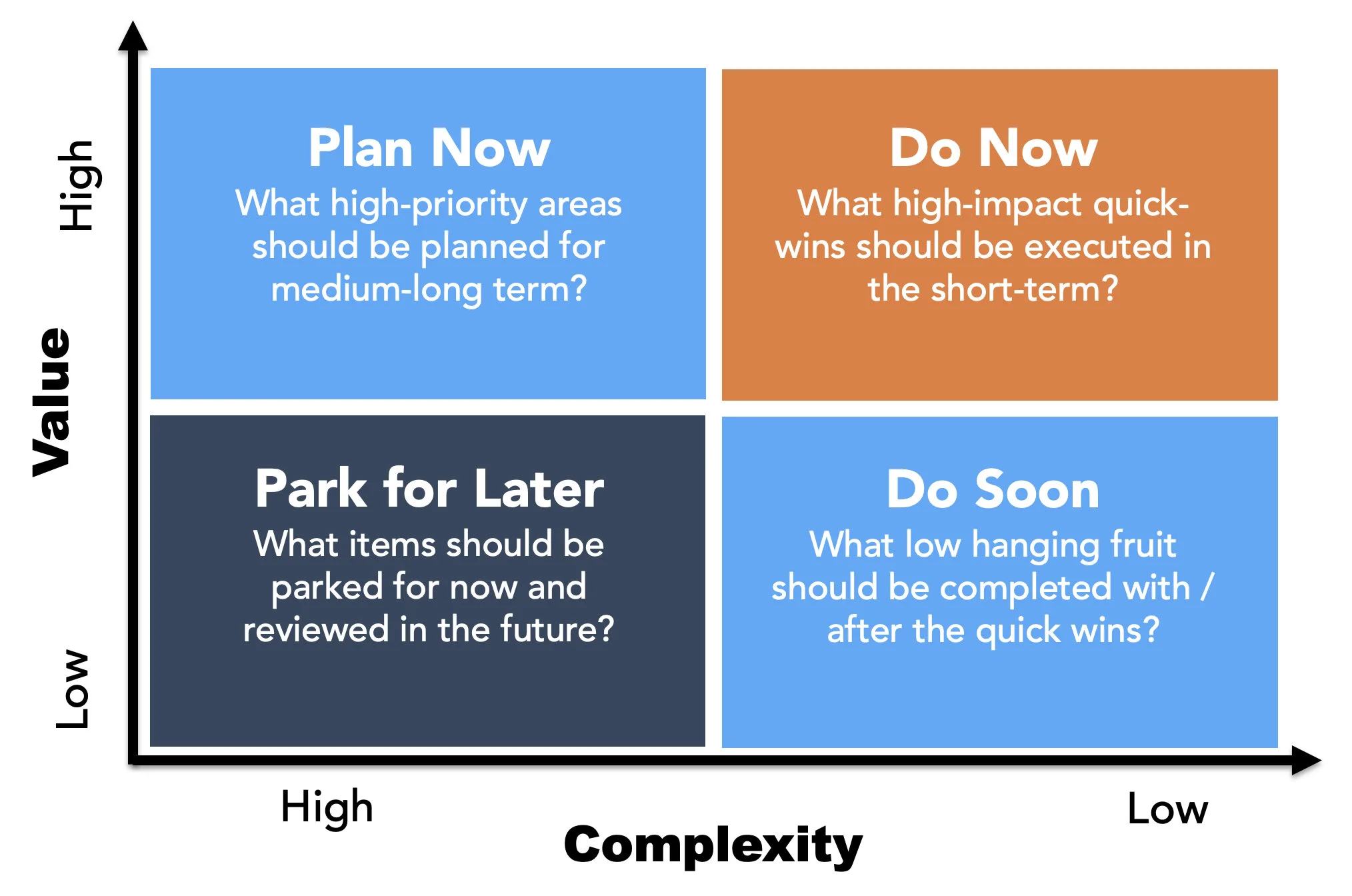
Steps
To start, capture all of the potential initiatives in enough detail that all team members understand what is being proposed. Use a standard template, and make sure to prepare ahead of any prioritization session.
Align teams on the criteria that will be used to prioritize each initiative. Have this documented and visible for each member of the team so it can be easily referenced throughout the prioritization activity.
Evaluate each activity individually as a team. Plot each activity on the corresponding position within the framework. It is important that everyone can see the working framework as it is populated together.
Make sure to capture any additional notes or clarifications for the initiatives as you review them. Also, expect that additional initiatives will be identified, so be prepared with blank templates to fill out during the activity.
After the first pass of the prioritization activity, review the results as a team. You will likely have a number of initiatives crowded in the High Value quadrants. Take a second pass to see if you can create more separation.
Considerations
Have business stakeholders involved to evaluate value and project managers to evaluate complexity.
Do not skip any of the prep work, like documenting the initiatives and creating the prioritization criteria.
Avoid getting into discussions regarding the timing of implementation, that comes next.
References
Prioritization Criteria Framework
Description
The purpose of the Prioritization Criteria Framework is to determine the relative priority of different initiatives based on the goals and capabilities of your organization. The framework is typically used when you have identified several potential initiatives and need to choose what to tackle first. While there are many iterations of this framework, most are based on the concepts of value and complexity. Value refers to what is important to you and your customers. Complexity refers to the level of difficulty or resources required for implementation. This framework forces you and your team to align on what represents value and complexity for your organization. Once the criteria has been finalized, you can begin evaluating different initiatives to determine relative priority.
Questions
The Prioritization Criteria Framework helps to answer marketing questions like:
How can we prioritize the different marketing initiatives that we have identified?
What exactly do we mean when we say that this initiative is valuable or complex?
How do we distinguish between something being low, medium, or high value or complexity?
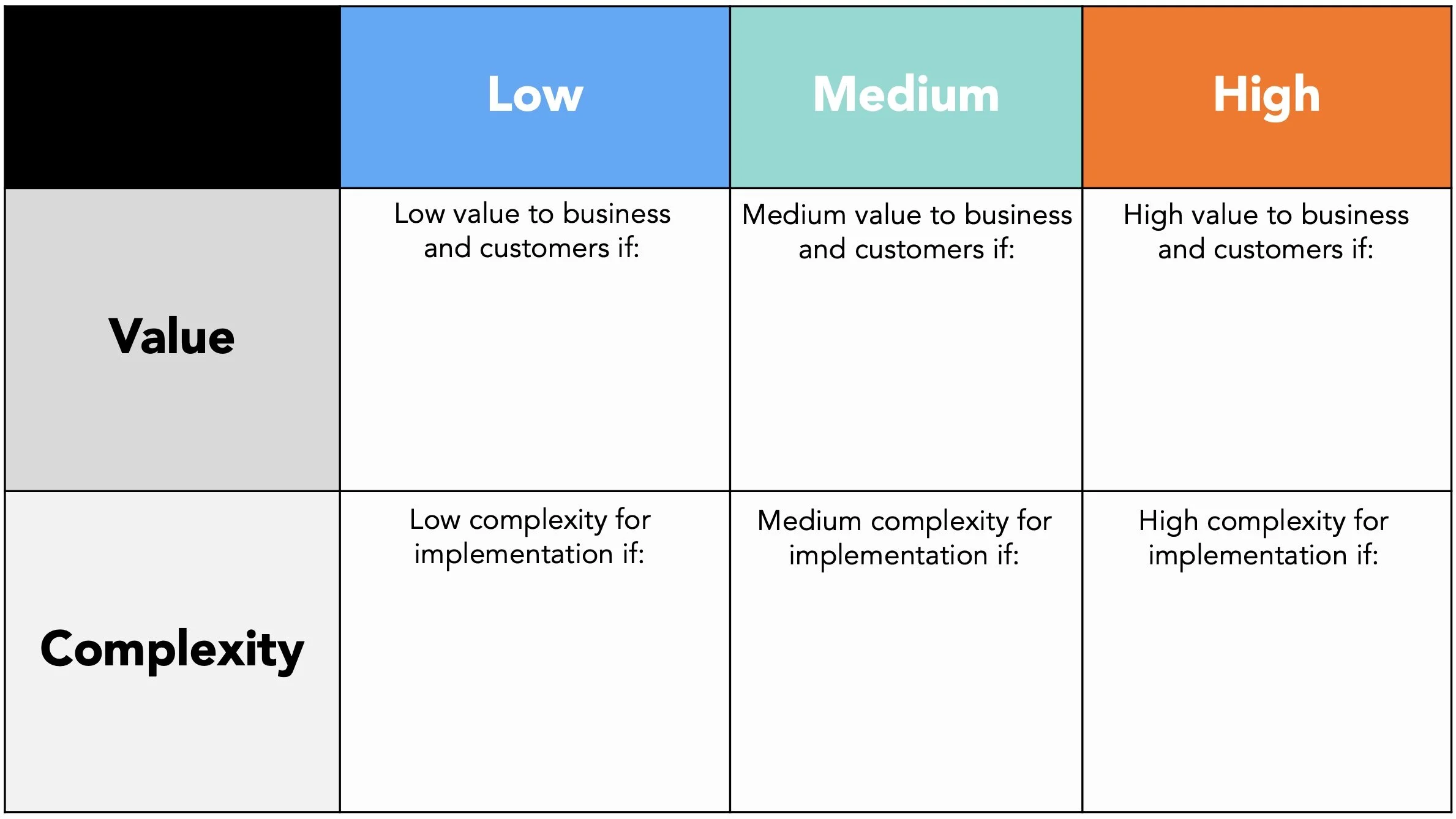
Steps
To start, make sure you are clear on the scope of what you are planning to prioritize. The criteria that you develop needs to be relevant to the potential initiatives that you have identified.
Determine what value means to your organization. This should be based on the degree to which an initiative contributes to a business goal, and the value or interest that a consumer will place on the initiative.
Assess how you will distinguish between low, medium, and high value. Be quantitative and specific. For example, if a new feature is expected to produce a <1% lift in sales it is low, 1-2% is medium, >2% is high.
Determine what complexity means to your organization. This should be based on the amount of time, resources, dependences, and risk that executing the initiative represents to your organization.
Assess how you will distinguish between low, medium, and high complexity. Again, try and be as specific as possible. Consider all of the relevant people, processes, systems, and resources required to execute.
Finally, stress test your Prioritization Criteria Framework by using it to prioritize a cross-section sample of your initiatives. Does the criteria apply? Are the results useful? If not, return to Step 1.
Considerations
Ensure that you are not creating the criteria to lead to the results you want. No agendas.
The more objectivity and specificity you can apply to the criteria, the more useful it will be.
If Low, Medium, and High is too broad and blunt, try using a scoring system instead (e.g., 1-5).
References
Brand Architecture Models
Description
The purpose of a Brand Architecture Model is to help a company organize its portfolio of brands, products, and services to support a business strategy. These models help illustrate the hierarchy, linkages, and roles for each brand. Brand architecture is fundamental to marketing decision-making, from setting budgets to designing websites. There are four main models: Branded House, House of Brands, Endorsed Brand, and Sub-Brand. Each model has its own set of potential advantages and disadvantages. Companies need to determine the right model based on their own unique situation and strategy. Establishing a coherent brand architecture makes marketing more efficient and effective by providing greater focus and clarity for internal stakeholders and consumers.
Questions
Brand Architecture Models help to answer marketing questions like:
Is this brand separate or connected to another brand?
What is the hierarchy of these brands that are connected?
What specific role does this brand play in our portfolio?
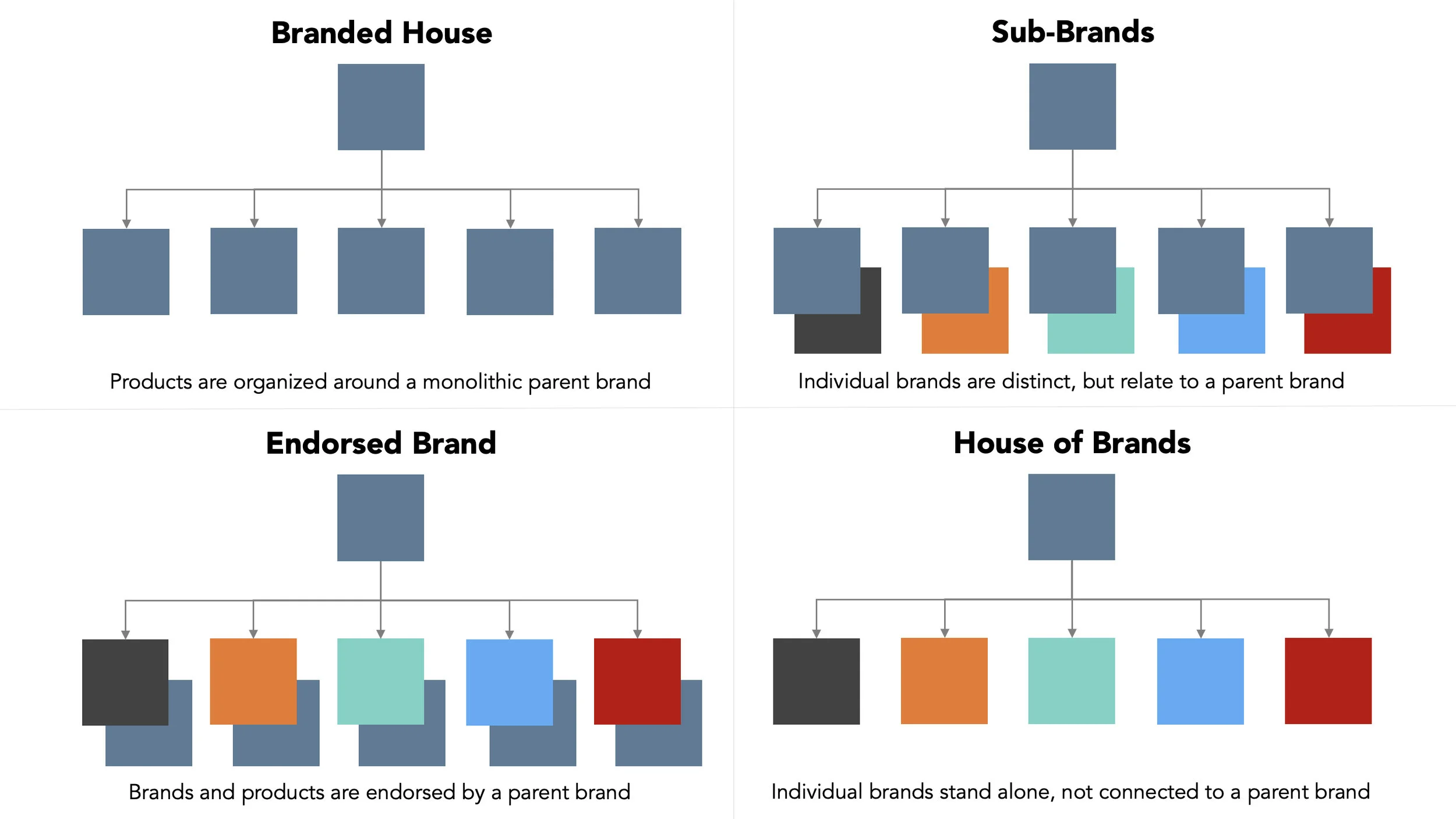
Steps
To start, ensure you have a clear understanding of your business strategy and factors that may impact your brands. Consider future mergers/acquisitions, line extensions/ consolidations, or changes in markets/positioning.
Audit your current portfolio of brands, products, and services. If you have an existing brand architecture, audit that as well. Analyze how your ‘current state’ may need to change to support your business strategy.
Evaluate how different models may address your needs. For example, a Branded House may limit extensions but consolidate investment. A House of Brands may enable diversification but require more resources.
Map your individual brands, products, and services to your chosen model. Many organizations use a hybrid approach, so highlight important nuances or exceptions. Stress-test against your business strategy and future plans.
Finally, ensure that your revisit your brand architecture over time to ensure that it is in tune with your business strategy and portfolio. As your business evolves, your brand architecture should evolve with it.
Considerations
Ensure that your approach provides sufficient clarity and separation between brands where required.
Consider how to reach your target market with fewer brands, as each brand requires additional budget.
Make sure that you do not map your brand architecture to your internal organizational structure.
References
Before-the-Brief Framework
Description
The purpose of the Before-the-Brief Framework is to help organize your early conversations and thoughts regarding a potential marketing initiative. The framework includes a set of fundamental questions that need to be answered before you can responsibly start a project. For this reason, I often refer to this framework with clients and stakeholders ‘before the brief’, to ensure that we have a shared understanding of the big picture before getting into the weeds. I mentally visualize this framework during these initial conversations, rather than printing or sharing the document. Establishing clear answers to these questions early – filling the frame – can help you move into the subsequent briefing phase with greater clarity and confidence.
Questions
The Before-the-Brief Framework helps to answer marketing questions like:
Why is an investment in marketing required in the first place?
What does success look like for this potential marketing initiative?
What factors do we need to keep in mind when developing a solution?
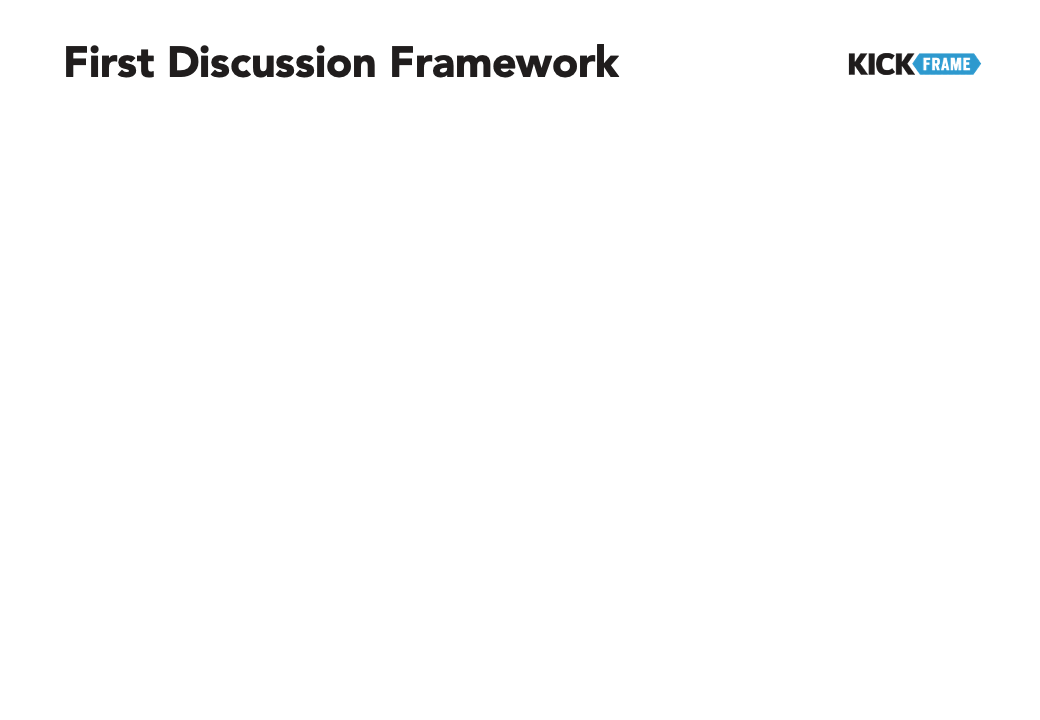
Steps
Start by trying to understand the underlying Mission, and the reason why marketing may be required. Do not assume that marketing is the best or only way to achieve this Mission and make change happen.
Try to get a clear sense of the gap that needs to be closed, between Start and Finish. Discuss the scope of what needs to happen to achieve the Mission, and what success ultimately looks like.
Explore the main factors that will act as Barriers or Boosters for your marketing initiative. These may be internal or external factors, some of which you may not be able to control. Best to know them now.
Discuss other Constraints that need to be considered when developing the marketing plan. For example, are there high-level budgets, dates, milestones, dependencies, or risks to consider?
Finally, allow space to discuss any other items that a team creating a plan should know about. For example, ask the client or stakeholder ‘what have we not talked about, but should?’ Empty the tank.
Considerations
The goal is to facilitate a conversation, don’t expect clients or stakeholders to have all of the answers now
This framework can be used for intake discussions, to triage marketing requests before work is started
Do not confuse this framework for a proper marketing brief, more details are required to start work.
References
Digital Marketing Maturity Model
Description
The purpose of a Digital Maturity Model is to visualize the how your organization will adopt increasingly sophisticated digital marketing tools and tactics. The Model helps you to illustrate your current state of digital maturity relative to your desired future state. Phases are used to group new digital tools and tactics together coherently, in a sequence that your organization can realistically execute. By planning digital maturity sequentially, you can identify the specific elements that need to be in place to help enable the release of future tools and tactics. Ultimately, the phasing of the Model should align with the overall goals, strategy, and relevant milestones of your business.
Questions
The Digital Marketing Maturity Model helps to answer marketing questions like:
Where are we today in terms of our digital marketing maturity?
How do we want our digital marketing to mature in the future?
What changes to our digital marketing activities will be implemented next?
Steps
Align your team on the goals, strategy, and relevant milestones for your organization. While these will not be included explicitly in your Model, your recommendations need to align to the bigger picture.
Align your team on the scope of what your Model will include and will not include. You can make this explicit by labeling different sections of each phase, represented by the horizontal ‘swim lanes’.
Capture your ‘current state’ of digital maturity as the first phase. Add details in the column by describing your current capabilities relating to the aspects of digital marketing you are capturing in your Model.
Capture the new tactics, features, or marketing use cases you plan to release in each phase of the top row. Organize phases based on the relative time, resources, and complexity associated the items.
For each item added to a future phase, analyze what is required to enable it. Capture these requirements in the bottom row. This will likely lead you to re-phase the different items above based on timing.
Considerations
Consider completing the model with a cross-functional team to validate priorities and feasibility
It can be helpful to add names or themes to each of the phases for internal communication purposes
Ensure everyone understands the Model is a high-level business-view of digital maturity, not a delivery plan
References
5 Whys Technique
Description
The purpose of the 5 Whys technique is to identify the root cause of a problem. This technique was originally developed at the Toyota Motor Corporation in the 1950s as a way to improve manufacturing processes. It has since been adopted in different forms and in different fields as a way to iteratively interrogate a problem. In marketing, 5 Whys is often used as a way to identify consumer insights. Often, marketers rely on facts and observations rather than insights into what fundamentally motivates consumer behaviour. The 5 Whys forces marketers to dig deeper by challenging early assumptions and conclusions.
Questions
The 5 Whys technique helps to answer marketing questions like:
What is motivating a consumer to behave this way?
What is our target consumer fundamentally seeking?
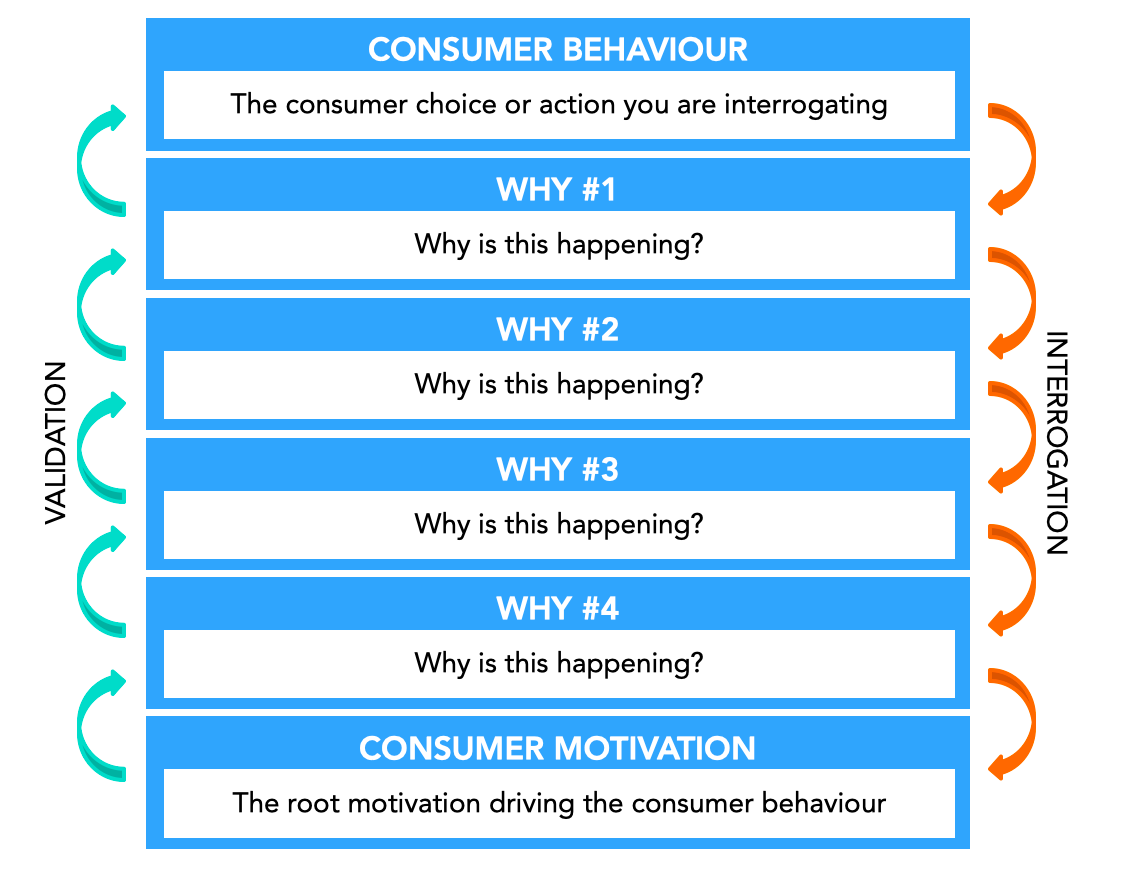
Steps
For marketers using 5 Whys to understand consumer motivation, begin by identifying the specific consumer choice or behaviour you are interrogating. What exactly do you want deeper insight into?
Review this consumer choice or behaviour and ask yourself “why is this happening?” Identify the different causes for this action. Select the primary cause based on your best facts and knowledge.
Consider this cause, and again ask yourself “why is this happening?” and write down the primary cause. Repeat this step 3 more times, or at the point where you are no longer able to identify useful causes.
Review the final cause that you have identified to see if it is a useful consumer insight. Does this capture a consumer’s motivation in a way that will help your marketing? If not, repeat the previous step.
Finally, stress test your work by reviewing your 5 Whys reverse. For each cause, ask yourself “does this happen when this happens?” This will help ensure that symptoms and causes are separate and aligned.
Considerations
If you identify different causes worth exploring, capture as branches connected to your originating statement
The number 5 is purely anecdotal, ask ‘why’ as many times as you need to arrive at a useful insight
A useful insight is relevant to your brand, differentiated from your competitors, and actionable for your marketing
References
The 5 Whys was created by Taiichi Ohno, Former Executive Vice President of Toyota Motor Corporation
Brand Benefit Ladder
Description
The purpose of the Brand Benefits Ladder is to translate product or service features into relevant psychological benefits for consumer. The Brand Benefits Ladder is based on the theory that brands that connect with consumers on a more emotional level build stronger equity and loyalty. Completing this framework forces marketers to view their functional attributes and benefits through the eyes of their target consumer. The ladder also ensures that there is alignment and credibility between the functional and emotional benefits of the product or service. Once completed, a Brand Benefit Ladder can be used as a tool to create more distinctive and emotionally resonant marketing communications.
Questions
The Brand Benefits Ladder helps to answer marketing questions like:
What product attributes do we offer that benefit our target customers?
Why should target consumers care about our product or service?
How should our target consumers ultimately feel about what we offer?

Steps
Identify your target consumer. Use research to understand the relevant needs, values, attitudes, and behaviours that define them. Make sure you can easily empathize with this consumer as a person.
List the functional attributes of your product or service. Consider all of the specifications, features, and dimensions of your offering. Focus on those that provide your brand with a competitive advantage.
Move up the ladder, and identify the tangible benefits that your product attributes deliver. Review each item listed and ask yourself “what functional benefit or advantage does this attribute provide?”
Move up the ladder and take the perspective of your consumer. Review the Product Benefits and ask yourself “what value do I get from that?” Narrow your list to the most compelling Consumer Benefits.
Move to the top rung of the ladder and review your Consumer Benefits from a more emotional perspective. Go deep, and ask yourself “how does this brand make me feel?” Narrow to what your brand can own.
Considerations
Moving up the ladder, focus on those items that are valuable to consumers and distinctive to your brand.
Ensure your target consumer profile is rooted in relevant and current market research to avoid bias.
Revisit your ladder when your target consumer, competitors, or product offering change significantly.
References
The Brand Benefits Ladder was first introduced by Philip Kotler and Kevin Lane Keller
Advertising Planning Framework
Description
The purpose of the Advertising Planning Framework is to consider and capture important strategic elements of a modern advertising campaign on a single page. This is a useful exercise, as advertising campaigns have become more integrated, digital, and data-driven. Often, the creative strategy (what you want to communicate) and the media strategy (how you are going to activate the communication) are considered separately which can cause misalignment. Using an Advertising Planning Framework allows marketers to explore opportunities relating to targeting, segmentation, and the use of data earlier in planning process. The Framework can also be used as workshop tool with a group, to capture ideas for different potential advertising campaigns.
Questions
The Advertising Planning Framework helps to answer marketing questions like:
Who is our advertising campaign targeting and how will we engage them?
What is the objective of our advertising campaign and how will we measure success?
What touchpoints and targeting techniques are in scope for this advertising campaign?

Steps
Determine the scope of the advertising campaign that you are focusing on. Are you trying to generate ideas for multiple campaigns, or is there a specific campaign you are planning? Be clear and precise.
Complete the top row, from left to right. These are the primary elements of your communication strategy, often part of a creative brief. Make sure your business goals, target segments, and proposition align.
Complete the bottom row, from left to right. These are the primary elements of your activation strategy. Consider how data and advertising targeting techniques can be used to reach audiences with precision.
Review what you have captured in your framework. Does everything align? If not, you may need to revisit different elements in the framework or create separate frameworks for different campaigns.
Once completed, validate the plan. Speak with marketing leads to refine the communication strategy and media leads for the activation strategy. Ensure the expected campaign cost do not exceed expected value.
Considerations
Use the framework early in the planning process to align teams on general direction.
The framework is best used as a way to capture high-level opportunities, not detailed requirements.
Before you start, decide if you are using the framework to generate ideas or to capture a single recommendation.
Get-Who-To-By Line
Description
The purpose of a Get-Who-To-By line is to capture your marketing strategy in a concise way for a creative brief. Often, creative briefs are not brief at all. Many contain so much information that the creative teams receiving the briefs are unclear and overwhelmed. The Get-Who-To-By line synthesizes and distills the most important elements of the creative brief into a single line. It includes your target audience, the problem they are facing, the response you desire, and your main proposition or message. When written well, the Get-Who-To-By line is effective tool to communicate your marketing strategy in clear and conversational way for your team.
Questions
The Get-To-Who-By line helps to answer marketing questions like:
What is the strategy behind this marketing program?
What is this marketing program trying to accomplish?
Who are targeting and what do we want them to do?
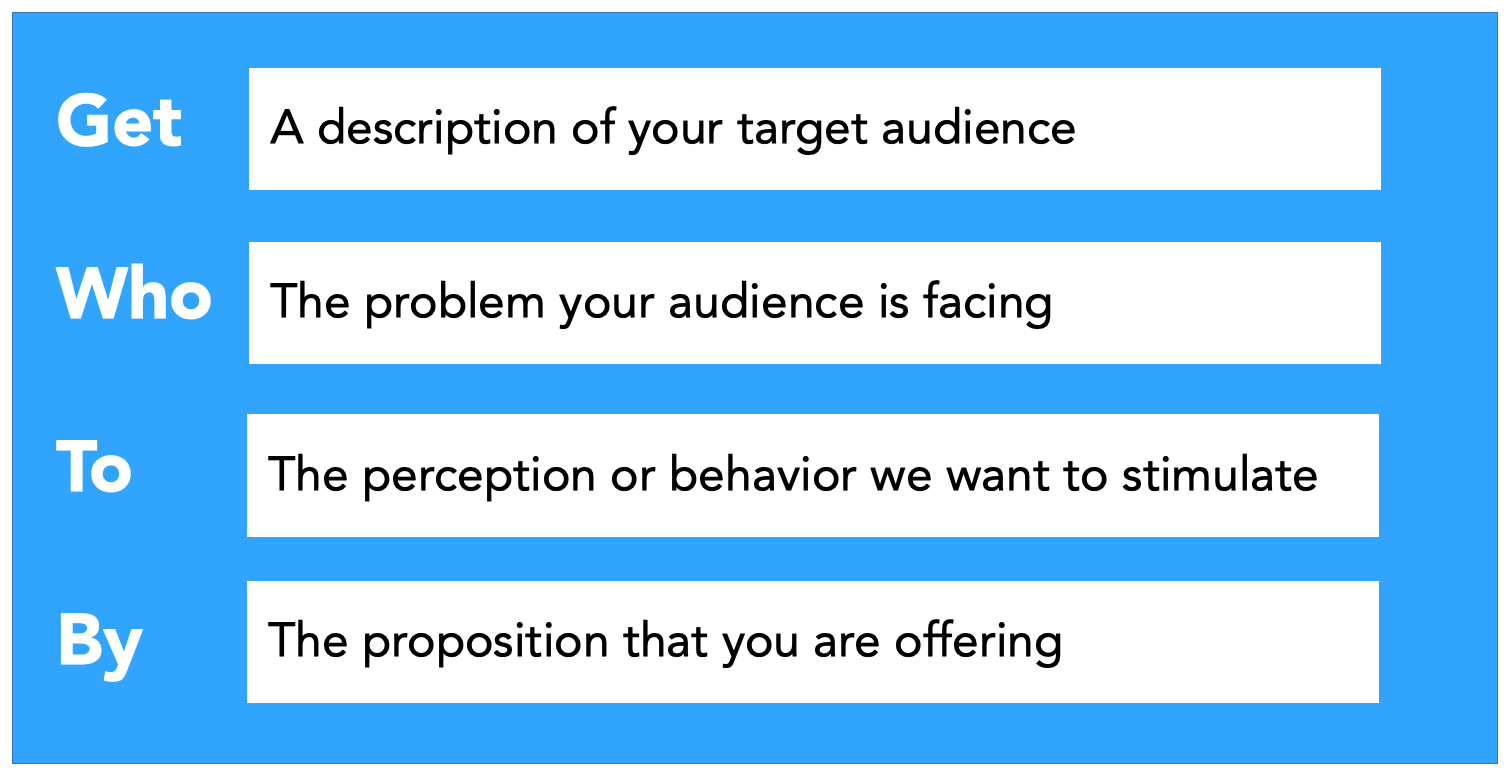
Steps
Describe the audience that you are targeting. This may be an existing audience persona or customer segment for your brand. Capture as specifically as possible to narrow the focus of your team.
Describe the relevant target audience problem. This sets up the situational context and the opportunity for your brand to ultimately address. Ensure this is a truth from the audience, not a desire from the brand.
Describe your desired audience response. The response may be how you want to change audience perception or stimulate behaviour. This represents what you want your initiative to ultimately achieve.
Describe your proposition. For marketing campaigns, this is the single message that you want to communicate. This ultimately addresses the audience problem (‘Who’) and creates change (‘To).
Once all sections are completed, review your Get-Who-To-By line to ensure that it is aligned and coherent. Include it prominently within your creative brief document and in your briefing meeting.
Considerations
When writing a creative brief, write your Get-To-Who-By line last as a way to crystalize your strategy.
Where relevant (and not overwhelming), include additional information to provide context to your line.
Remember to use your Get-To-Who-By line as a lens to evaluate creative ideas.
References
The Get-Who-To-By Line is credited to BBDO.
Audience Personas
Description
The purpose of an Audience Persona is to communicate details about a specific segment of your target audience that are useful when designing a solution for them. An Audience Persona is a fictional representation of a segment that has similar needs, behaviours, and goals in relation to your offering. Personas should be created based on how they will be used, and only include details that are relevant to this scope. Personas differ from customer segments used in marketing departments in that they focus on common needs rather than common demographic traits. Marketers should use audience research to inform personas to avoid bias, and develop personas as a group to gain alignment.
Questions
The Audience Persona helps to answer marketing questions like:
Who are we designing our product or service for?
What qualities of our offering are most important to our target audience?
How does our offering fit in the life of our target audience?
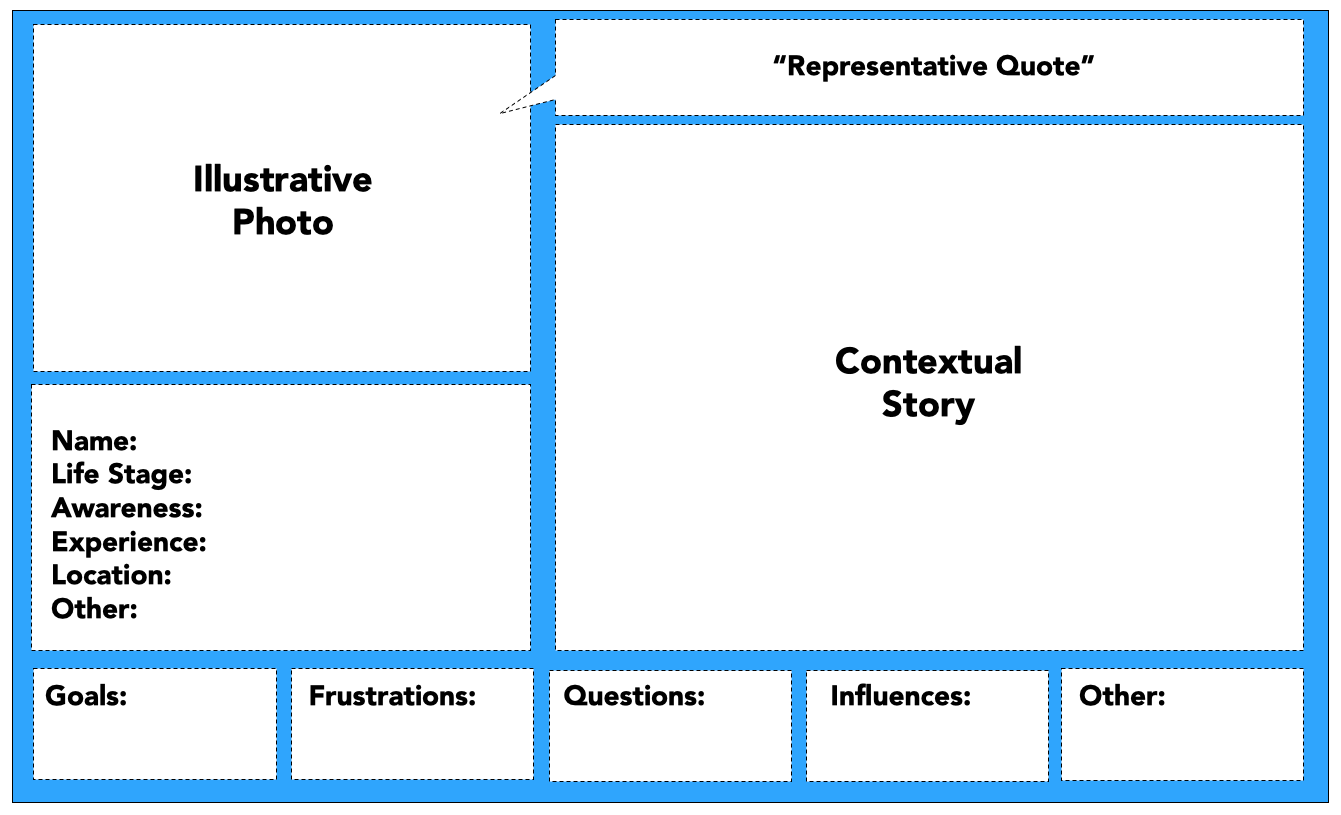
Steps
Determine the scope of your focus. This may be the business line, marketing program, product, or service that you are designing. Consider how broad or narrow your personas need to be in order to help.
Conduct audience research, focusing on those attributes and questions that are most critical to your scope and where relevant findings are not available. Persona accuracy increases with research depth.
Create audience segments based on your research. Review and organize all of your findings. Look for similarities and patterns across your data, and create audience segments based on meaningful attributes.
Document details for each audience persona. These details need to define each group and be helpful for the teams using the persona. Avoid extraneous details that are not relevant, and may distract focus.
Humanize your audience persona. Create a document for each persona that includes the salient details, along with a realistic personal description and a narrative that makes the persona relatable and unique.
Considerations
Creating too many personas will distract your focus. Use a maximum of 7.
Avoid creating personas based on assumptions. Find ways to research even when resource-constrained.
Ensure you update personas over time as your offering changes and new data is available.
References
KPI Tree
Description
The purpose of the KPI Tree Template is to identify the specific Key Performance Indicators (KPIs) that you will use to evaluate your performance in relation to a strategic goal. KPI Trees are developed by marketing teams to ensure that there is alignment between strategic goals (what you ultimately want to achieve) and tactical metrics (what you will measure if you achieve it). To complete a KPI Tree, you need to complete your marketing strategy first. A completed KPI Tree ultimately visually explains your strategic approach and provides the basis for creating a detailed measurement plan – on a single page.
Questions
The KPI Tree Template helps to answer marketing questions like:
What is the overall strategic goal for our marketing initiative?
How does this tactic ladder up to our overall strategic goal?
What will we measure to understand if we are successful?
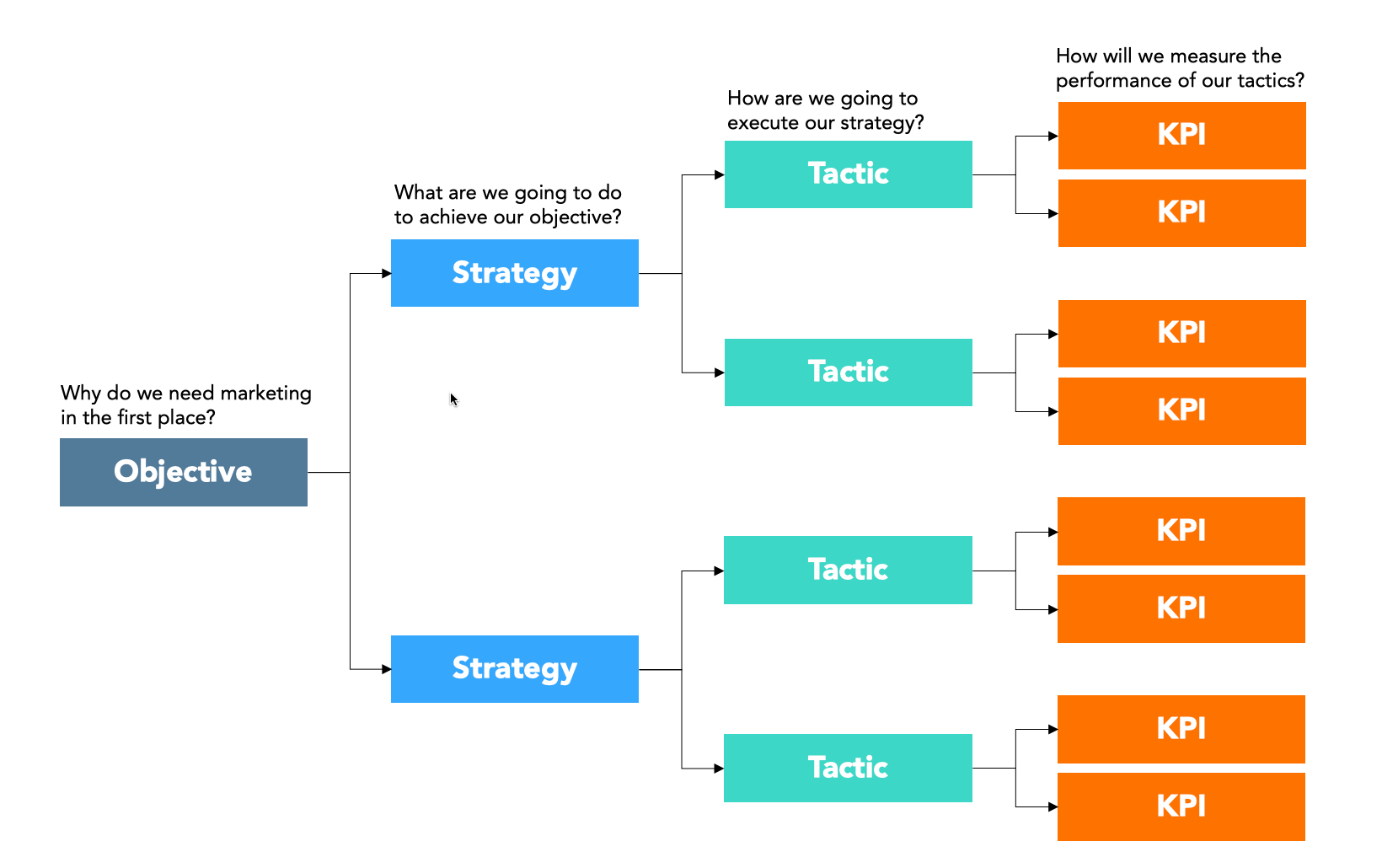
Steps
Identify the single strategic objective that you need to accomplish. This is the ‘why’ that underlies your marketing initiative. If you have more than one objective, you need more than one KPI tree.
Determine a set of strategic levers that you will use to achieve your objective. This is the ‘what’ you will do as part of your marketing strategy. Ensure that these are mutually exclusive from each other.
Identify the individual tactics that you will execute to support your strategy. This is the ‘how’ you will execute your marketing initiative. Capture and describe all tactics with the same level of detail.
Identify the KPIs that demonstrate how well each tactic supports a strategic lever, and ultimately your strategic objective. Capture only those KPIs you will use to make decisions and manage your initiative.
Determine if there are any significant relationships among your KPIs. For example, a single KPI may be used to measure multiple tactics or different KPIs may be in conflict with each other. Record these relationships.
Considerations
Ensure that your KPIs are simple, relevant, actionable, measurable, and timely.
Consider assigning weights to KPIs to reflect the relative contribution of the tactic(s) they measure.
Update your KPI Tree when your marketing strategy or your measurement capabilities change.
References
Parmenter, D. “Key Performance Indicators. Developing, Implementing, and Using KPIs”, Wiley, 2019.
Customer Journey Map
Description
The purpose of a Customer Journey Map is to visualize the process that a person goes through to accomplish a goal. For marketers, Customer Journey Maps are typically used to understand what a customer is doing, thinking, and feeling as they progress towards a transaction or start using a product or service from the brand. This framework helps marketers adopt a more customer-centric point of view, and identify moments to provide value. These moments are typically associated with frustrations experienced by customers at specific points in their journey where their needs are not effectively met. Marketers can use a completed customer journey to explore new opportunities to address these pain points, and design a better and more connected experience for customers.
Questions
The Customer Journey Map helps to answer marketing questions like:
How does our product or service fit into the life of a customer?
What needs does a customer have at different stages of their journey?
What moments along a customer’s journey can we add the most value?
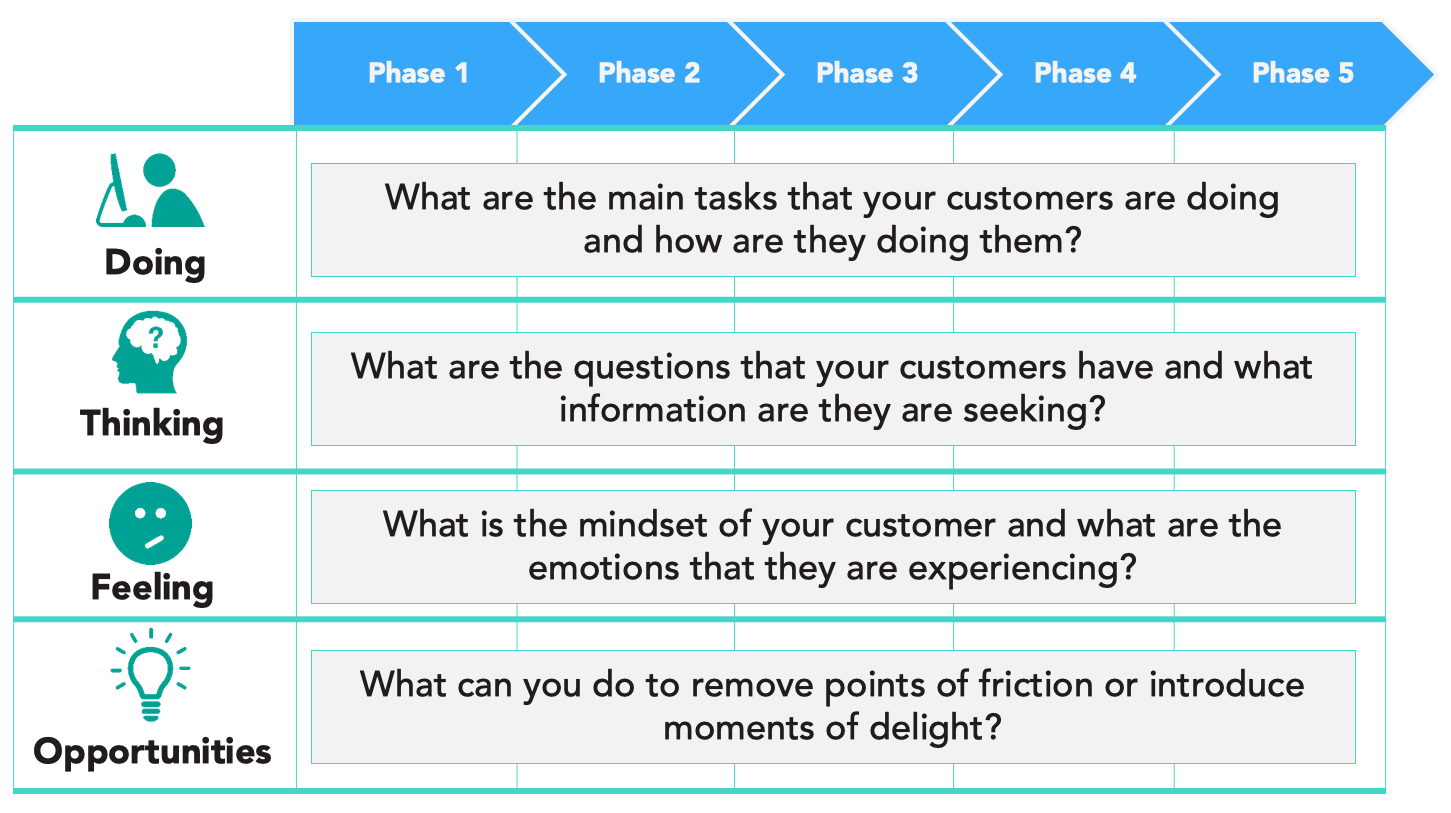
Steps
Identify a single customer persona and scenario to examine. Your personas should be based on customer research, and your scenario should include multiple steps and a clear customer goal.
Identify the high-level phases that a customer progresses through towards their goal. Capture these phases from the customer’s perspective. New phases start when a customer has a new need or focus.
Capture what the customer is doing (actions), thinking (questions), and feeling (emotions) at different phases of their journey. Populate the framework with data from customer research to avoid bias.
Review the Customer Journey Map and identify moments where a customer may be experiencing a heightened level of frustration or having difficulty progressing towards their goal.
Review the Customer Journey Map, ideally as a team, and identify opportunities where your brand may address these moments and provide a better and more connected experience for your customer.
Considerations
Customer personas are required to start a Customer Journey Map, one persona for each Map.
Customer Journey Maps can also be used to explore future state experiences for customers.
Customer Journey Maps can be used to analyze if your marketing channels are well integrated.
References
Customer Journey Mapping is credited to Chip Bell and Ron Zemke
Kalbach, J. Mapping Experiences: A Complete Guide to Creating Value through Journeys, Blueprints, and Diagrams. O’Reilly, 2016
Trend Exploration Framework
Description
The purpose of the Trend Exploration Framework is to synthesize trends that relate to your initiative, and analyze the resulting implications and opportunities for your brand. This type of framework is often used by marketers to explore how changes in the marketplace might impact future strategic plans. The Trend Exploration Framework is typically completed as a group in a workshop format, where participants are required to come prepared with research on current and relevant trends. Completing the framework as a team can be an effective way to create a shared understanding of the impact of key trends, and to collaboratively explore emerging opportunities for an existing brand.
Questions
The Trend Exploration Framework helps to answer marketing questions like:
What trends are impacting our brand most significantly?
How can we use marketplace trends to our advantage?
How do we need to change to be more relevant in the future?
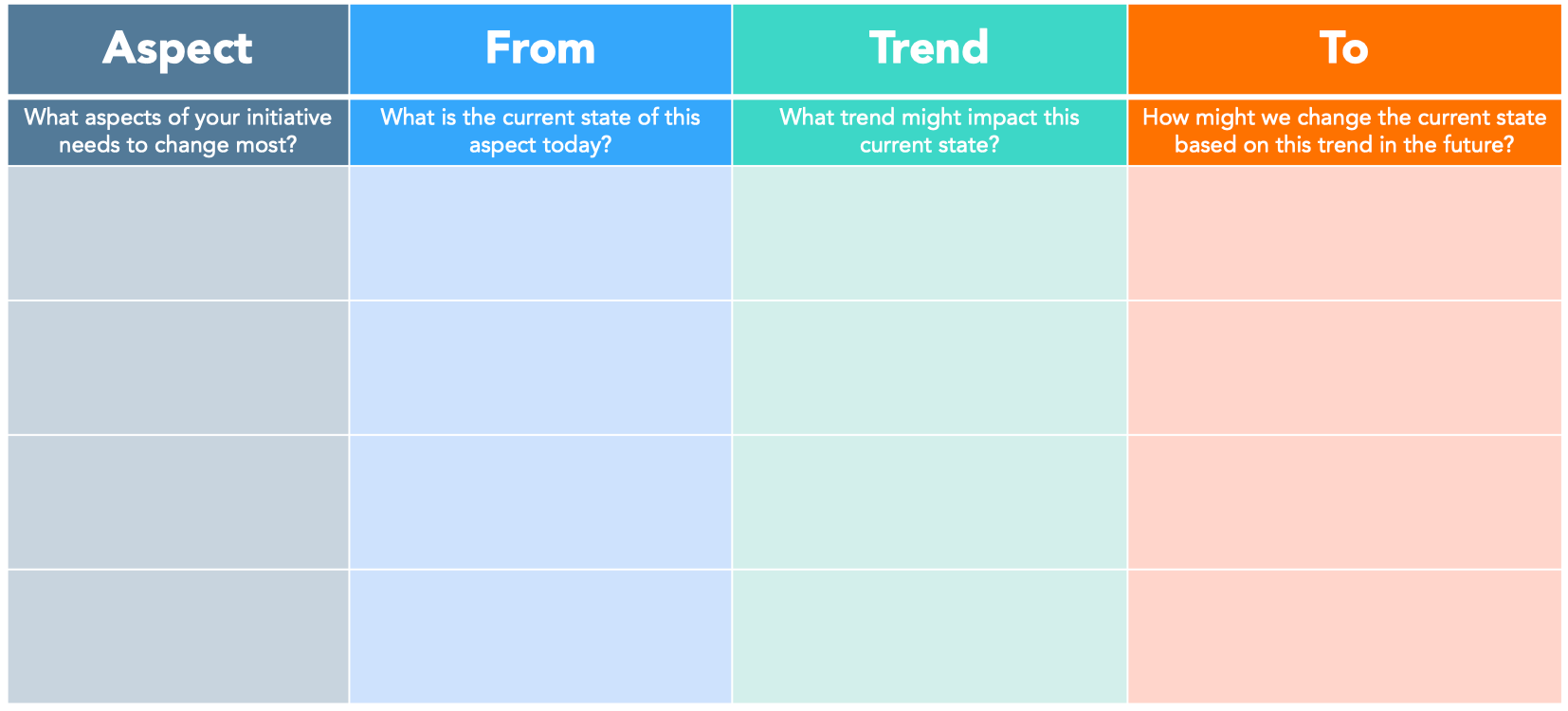
Steps
Identify aspects of your initiative that you suspect need to change the most. For marketers, this might be your product benefits, your service model, or your marketing communications. Capture up to 5 aspects.
For each aspect, research the latest trends. Capture these trends in a way that clearly describes the trend and the underlying cause. The connection between the trend and the initiative should be apparent.
Start filling in the framework by describing the current state for each aspect in the From column. Once completed, this should provide you with a snapshot of your existing context that needs to change.
Based on the trend research, explore how the current state might be reframed in a new way. For example, an emerging consumer trend might lead to a potential new produce line. Capture in the To column.
Review the completed framework, ideally with your marketing team, to identify and prioritize new opportunities together. Identify any additional research required to take these opportunities further.
Considerations
Analyze how different trends may be related and have similar causes, to identify new patterns
Revisit and update your framework over time to reflect the latest trends in your marketplace
The framework is most useful as an input to ‘big picture’ marketing planning
References
Kumar, V. 101 Design Methods – A Structured Approach for Driving Innovation in Your Organization. Wiley, 2013.
Micro Conversion Framework
Description
The purpose of the Micro Conversion Framework is to help identify and measure the granular customer behaviours that contribute to a larger business objective. Micro Conversions refer to actions that customers take that benefit a brand and lead to a larger goal – the Macro Conversion. These actions may be Process Milestones which are actions that a customer takes to progress towards the Macro Conversion, such as adding a product to a cart before completing an online transaction. Micro Conversions may also be Secondary Actions which are actions customers take that are proxies for marketing success, such as sharing brand content in social media. Micro Conversions are frequently used by marketers for website and app Conversion Rate Optimization efforts.
Questions
The Micro Conversion Framework helps to answer marketing questions like:
Where are customers or prospects dropping off in our marketing funnel?
What actions or tasks do we want more of our website and app users to complete?
How are we going to measure the impact of changes to our website or app?

Steps
Identify the relevant Macro Conversion for your brand. This is the larger business objective that you want more of your prospects and customers to ultimately achieve. Only select one Macro Conversion.
Identify the phases a customer progresses through towards your Macro Conversion, framed from their perspective. New phases start when a customer completes an action that leads to a new need or focus area.
Identify all of the Process Milestones that correspond with each phase. These are actions that a customer must take to progress towards the Macro Conversion. These actions must be measurable.
Identify all of Secondary Actions relating to your Macro Conversion. These actions do not necessarily correspond with separate phases but do contribute positively to the Macro Conversion.
Based on the completed Micro Conversion Framework, build Conversion funnels that measure the volume of customers that progress towards your Macro Conversion at each stage of their journey.
Considerations
Ensure that all Micro Conversions can be measured in a way that is accurate, timely, and precise.
Prioritize Process Milestones over Secondary Actions as they have a stronger direct impact on Macro Conversions
Prioritize Micro Conversions that you are able to more directly impact through your marketing
References
Kaushik, A. Web Analytics 2.0 – The Art of Online Accountability and Science of Customer Centricity: Sybex, 2009.
S.M.A.R.T. Goal Template
Description
The purpose of the S.M.A.R.T. Goal Template is to determine a clear and measurable goal for your marketing initiative. S.M.A.R.T. is an acronym for the qualities of an effective goal: Specific (target a specific area for improvement), Measurable (quantify an indicator of progress), Achievable (ensure it is possible to accomplish), Relevant (align with a larger business objective), and Time-bound (state when result will be achieved). Determining an effective goal is critical for marketers to create and approve marketing briefs, develop and provide feedback on marketing plans, and measure the effectiveness of marketing initiatives. Using S.M.A.R.T. goals consistently can help marketers keep their focus on marketing outcomes over marketing outputs.
Questions
The S.M.A.R.T. Goal Template helps to answer marketing questions like:
What does this marketing initiative ultimately need to accomplish?
What larger business objective does this marketing initiative support?
What do we need to measure to evaluate the performance of this initiative?
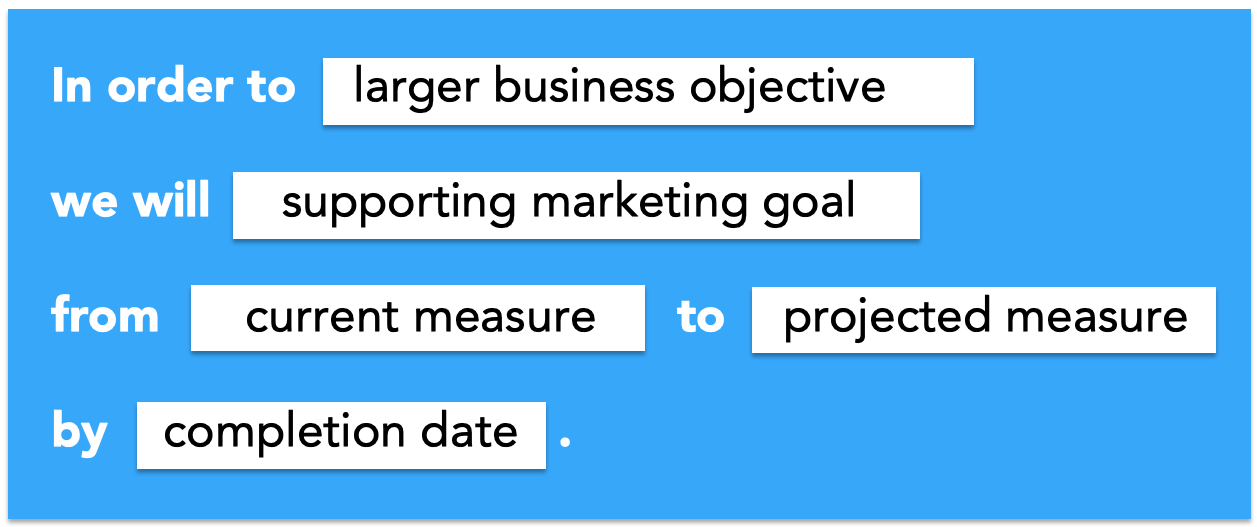
Steps
Determine the scope of your marketing initiative. The scope needs to be tight enough that it aligns with a single business objective and single marketing goal. Large, complex initiatives require S.M.A.R.T. goal sets.
Identify the larger business objective that your marketing initiative supports. This objective is what impacts your bottom line (e.g. increase market share) and necessitates marketing investment.
Identify the marketing goal that supports your larger business objective. This goal can be accomplished by marketing (e.g. acquire new customers) and becomes the focal point for your marketing plan.
Determine the metrics that you can use to measure your progress toward your marketing goal. These metrics need to be as accurate, timely, and precise as possible to report on your performance.
Identify the date that you need to accomplish your marketing goal to support your larger business objective. This date can be used to establish interim performance targets throughout an initiative.
Considerations
Request that business stakeholders identify their own S.M.A.R.T. goals to ensure alignment with marketing.
Use S.M.A.R.T. goals to calculate your anticipated return, which can be used to determine your budget.
Include S.M.A.R.T. goals within your marketing briefs and within your performance reviews where possible.
References
S.M.A.R.T. goal is credited to George T. Doran.
Doran, G.T. “There’s a S.M.A.R.T. way to write management’s goals and objectives”, Management Review, 70 (11): 35-36, 1981.
Empathy Map
Description
The purpose of an Empathy Map is to help teams develop empathy for and a shared understanding of people relative to a goal. For marketers, Empathy Maps are used as a way to organize qualitative research and knowledge about a particular target customer or persona. Empathy Maps are typically created collaboratively as a team to synthesize various observations and generate a shared understanding of the people the brand is trying to target and serve. To eliminate bias or assumptions, Empathy Maps should be created using actual customer research such as customer interviews and surveys. Once completed, Empathy Maps can be used by marketers for various purposes including designing new customer experiences and generating new product ideas.
Questions
The Empathy Map helps to answer marketing questions like:
What would our target customer think about this?
What is our customer doing to accomplish this?
What is our customer thinking or feeling about this?
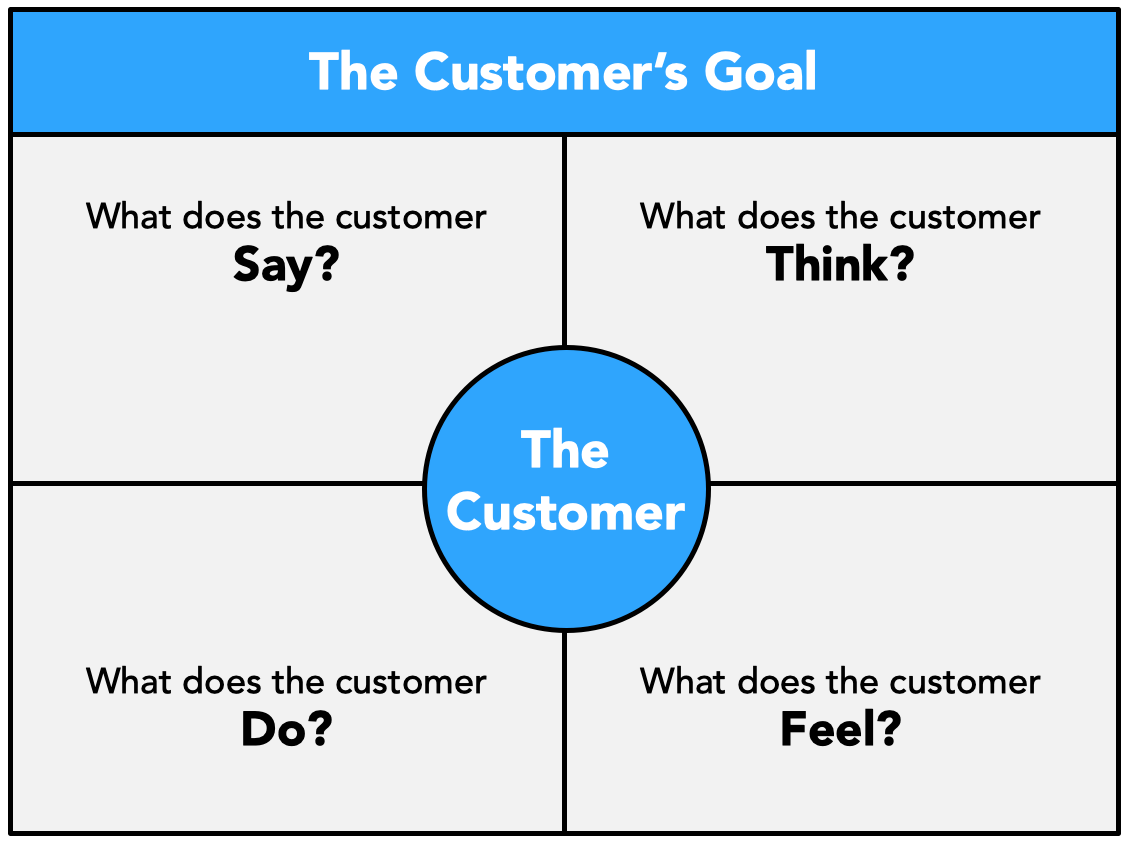
Steps
Gather all available research and data related to the target customer. If you are developing the Empathy Map during a workshop, ensure that all participants come prepared.
Define the specific target customer or persona that the Empathy Map is based on. Provide enough detail so you and other workshop participants understand who you are empathizing with.
Describe the goal of the target customer or persona to provide context for the Empathy Map. Write a single line describing what the customer is trying to accomplish in their own words.
Capture all of your observations about the person and their goal in the corresponding quadrants. Write down the observations in the first-person voice of the person whenever possible.
Review the observations to see what is common and group together, then look for observations that may be contradictory and try to resolve. Identify and discuss any new or unexpected insights.
Considerations
Empathy Map can be considered living documents and be updated with new research over time.
When reviewing a completed Empathy Map, look for gaps or questions that require additional research.
Empathy Maps are intended to complement, not replace customer personas and target audience profiles.
References
The Empathy Map was developed by Scott Mathews of XPLANE.